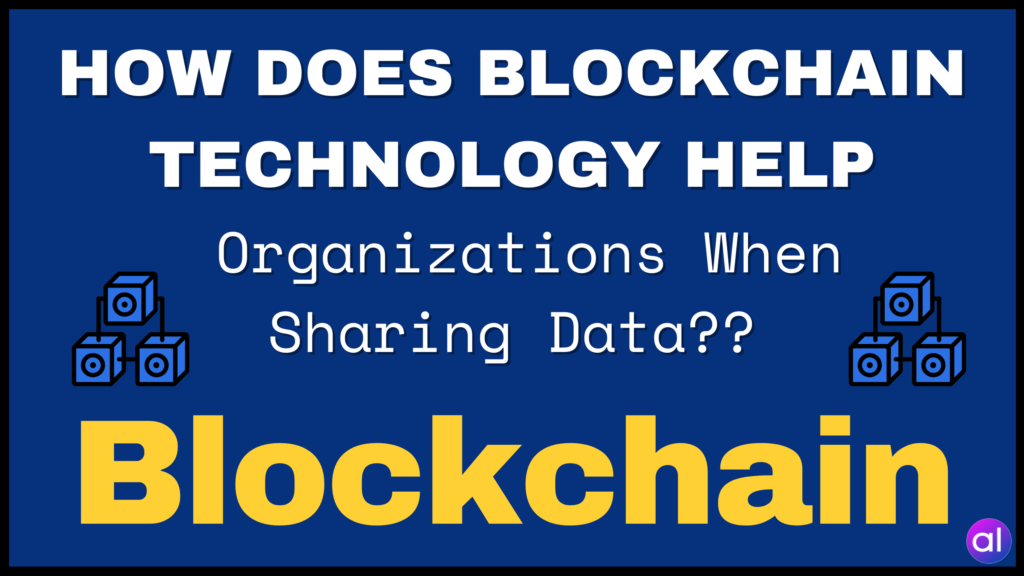As the adoption of blockchain technology continues to rise, so do the risks associated with it, such as frontrunning attacks, token scams, and vulnerabilities across different chains. Blockchain security protocols play a vital role in safeguarding every aspect of a transaction, from its initiation to confirmation, ensuring its protection. Understanding the importance of end-to-end transaction security is crucial for both users and developers to prevent losses and guarantee secure and uninterrupted interactions on the network. This article delves into the top protocols that are ensuring secure blockchain transactions in 2024.
In this guide:
- Top 5 blockchain protocols
- What is end-to-end transaction security?
- Is it enough to secure transactions with blockchain security protocols?
- Frequently asked questions
Top 5 blockchain protocols
In summary, some of the leading blockchain security protocols in 2024 are:
- Omnia Protocol – Providing protection against frontrunning with private mempools
- LayerZero – Utilizing private relayers for secure cross-chain communication
- Chainlink CCIP – Offering multi-layer validation for token transfers
- Wormhole – Ensuring cross-chain transaction safety through guardian nodes
- Cosmos Hub (IBC Protocol) – Facilitating secure asset transfers with Tendermint consensus
Let’s explore each of these blockchain security protocols in detail.
1. Omnia Protocol: Leading the way in preventing exploits
The Omnia Protocol ensures secure and private access to blockchain networks for users and developers, protecting them from frontrunning, token scams, and malicious activities.
By securing transaction data from start to finish, Omnia guarantees end-to-end security, maintaining confidentiality for every blockchain operation.

Users: Omnia protocol
How it operates?
Omnia serves as a secure tunnel for blockchain transactions. When users engage with a blockchain via Omnia’s private RPC endpoints, their data is shielded from public view, safeguarding it from potential attackers. These private mempools prevent bots from engaging in frontrunning trades or accessing sensitive information.
Additionally, Omnia identifies honeypots—scam tokens designed to deceive users—by analyzing smart contracts and transaction data in real-time.
Omnia is blockchain-agnostic and supports continuous transaction monitoring across multiple networks, ensuring extensive security coverage.
Pros
- Prevents frontrunning attacks: Private RPCs conceal transactions from bots.
- Blocks scam tokens: Detection of honeypots prevents interaction with fraudulent tokens.
- Multi-chain support: Works seamlessly across various blockchains, ensuring adaptability.
Cons
- Technical setup: Users may require time to grasp private RPCs and honeypot protections.
- Node dependency: Consistent node participation is necessary for uninterrupted access.
2. LayerZero: Ensuring secure cross-chain transactions
LayerZero guarantees the safe and uninterrupted completion of transactions between different blockchains. Cross-chain transactions introduce new risks, such as frontrunning and incomplete transfers, but LayerZero mitigates these vulnerabilities by securing every aspect of the transaction—from initiation on one blockchain to confirmation on another.
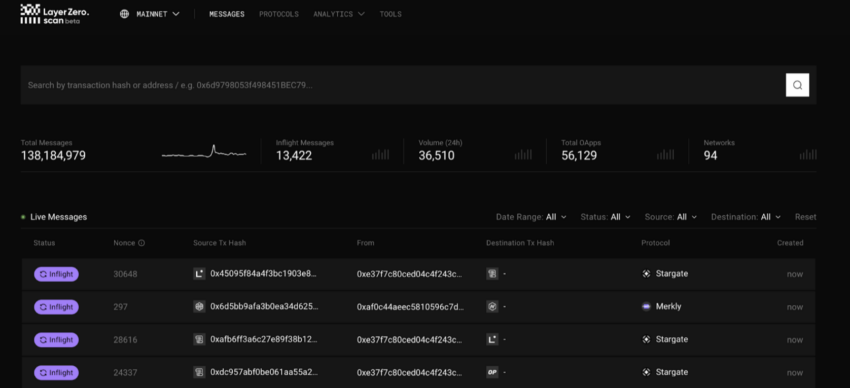
Interface: Layer Zero
How it functions?
LayerZero maintains speed and security by utilizing ultra-light nodes (ULNs), oracles, and relayers. It can be likened to sending a package through a trusted courier network, where relayers (couriers) and validators (oracles) ensure the package reaches its destination intact without interference from external parties.
ULNs validate transactions without requiring the entire blockchain’s data, ensuring network agility while upholding security.
Relayers transmit transaction data between blockchains while keeping it hidden from public view, preventing unauthorized access or manipulation of the data.
Oracles independently verify transactions on both the source and destination chains, maintaining data integrity during cross-chain swaps.
In terms of maintaining end-to-end transaction security, private relayers protect transaction data from manipulation or interception, while ULNs ensure secure validation.
Moreover, each component of the network operates independently, reducing the risk of system-wide vulnerabilities due to its resilient modular design.
Pros
- Effective frontrunning mitigation: Private relayers keep transactions out of public mempools.
- Rapid cross-chain execution: ULNs expedite transactions without compromising security.
- Reliable verification: Oracles ensure accurate validation of every transaction, safeguarding user assets.
Cons
- Complex setup: Users may initially find the architecture involving relayers and oracles challenging to understand.
- Dependency on validators: While decentralized, LayerZero’s operation relies on validators functioning properly.
3. Chainlink CCIP: Ensuring secure token transfers
Chainlink’s Cross-Chain Interoperability Protocol (CCIP) provides a dependable method for transferring tokens between blockchains while preventing errors or manipulation. By validating transactions at multiple stages, CCIP guarantees the security of each transfer from start to finish, making it an indispensable tool for secure cross-chain operations.
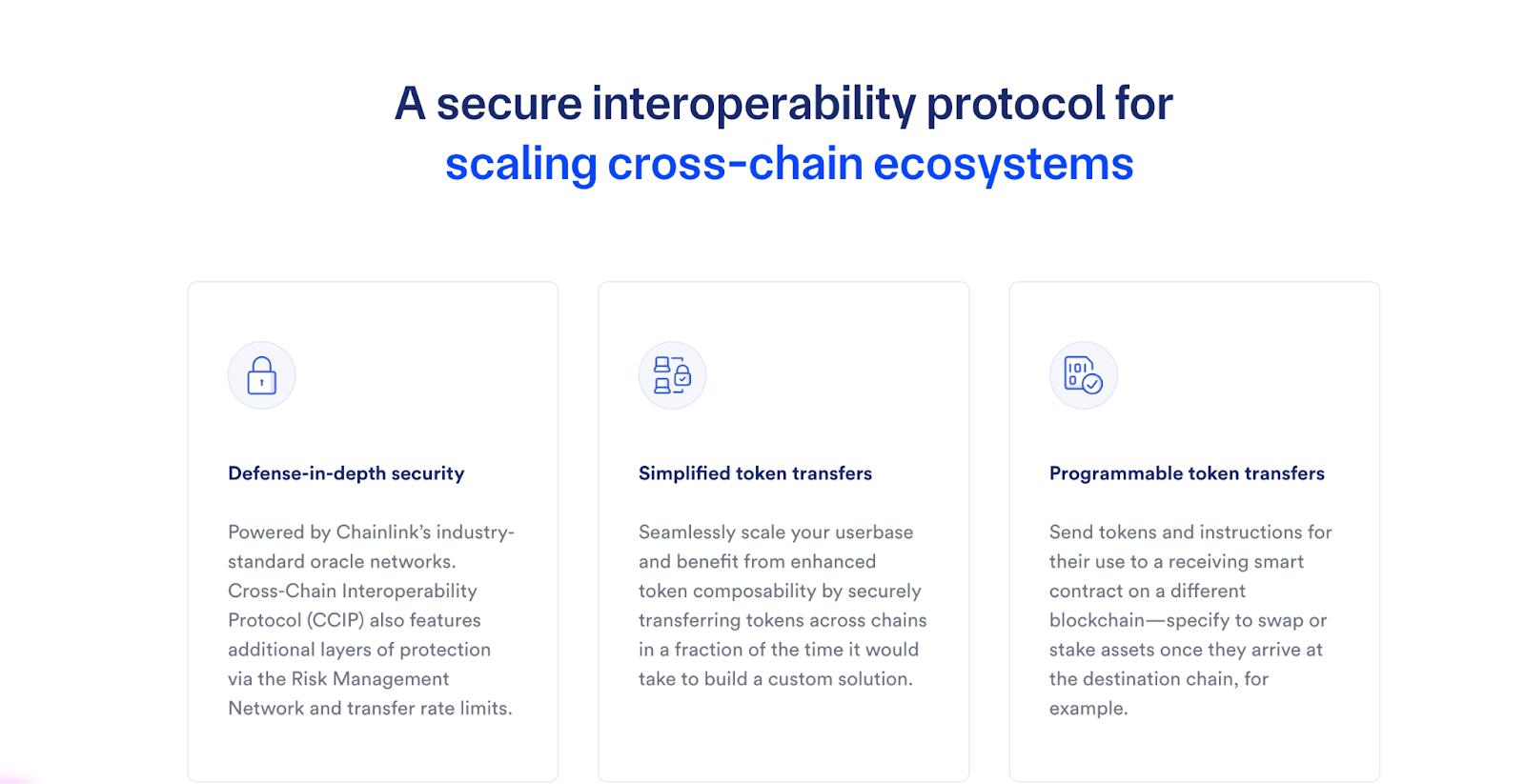
Chainlink protocol: Chainlink
How it operates?
CCIP functions as a checkpoint system for blockchain transactions. When tokens are sent between networks, oracles and validators collaborate to verify each step of the process.
Imagine sending a package where each post office stamps it along the way—this process ensures the package remains intact until it reaches its destination.
Chainlink CCIP employs multi-point validation, private communication channels, and flexible token handling to facilitate safer transfers and prevent errors.
Pros
- Protection against frontrunning: Transactions are kept private to prevent interference.
- Secure token transfers: Validation at multiple points prevents errors or losses.
- Flexibility across chains: Supports various networks for seamless asset movement.
Cons
- Learning curve: Users may require time to understand programmable transfers.
- Reliance on Oracles: Proper functionality depends on validators and oracles.
4. Wormhole: Securing transactions with guardian verification
Wormhole facilitates secure movement of assets and data across multiple blockchains, minimizing risks associated with cross-chain transactions.
Through its guardian node system, Wormhole independently verifies each transaction, preventing unauthorized or tampered transfers and ensuring end-to-end transaction security.
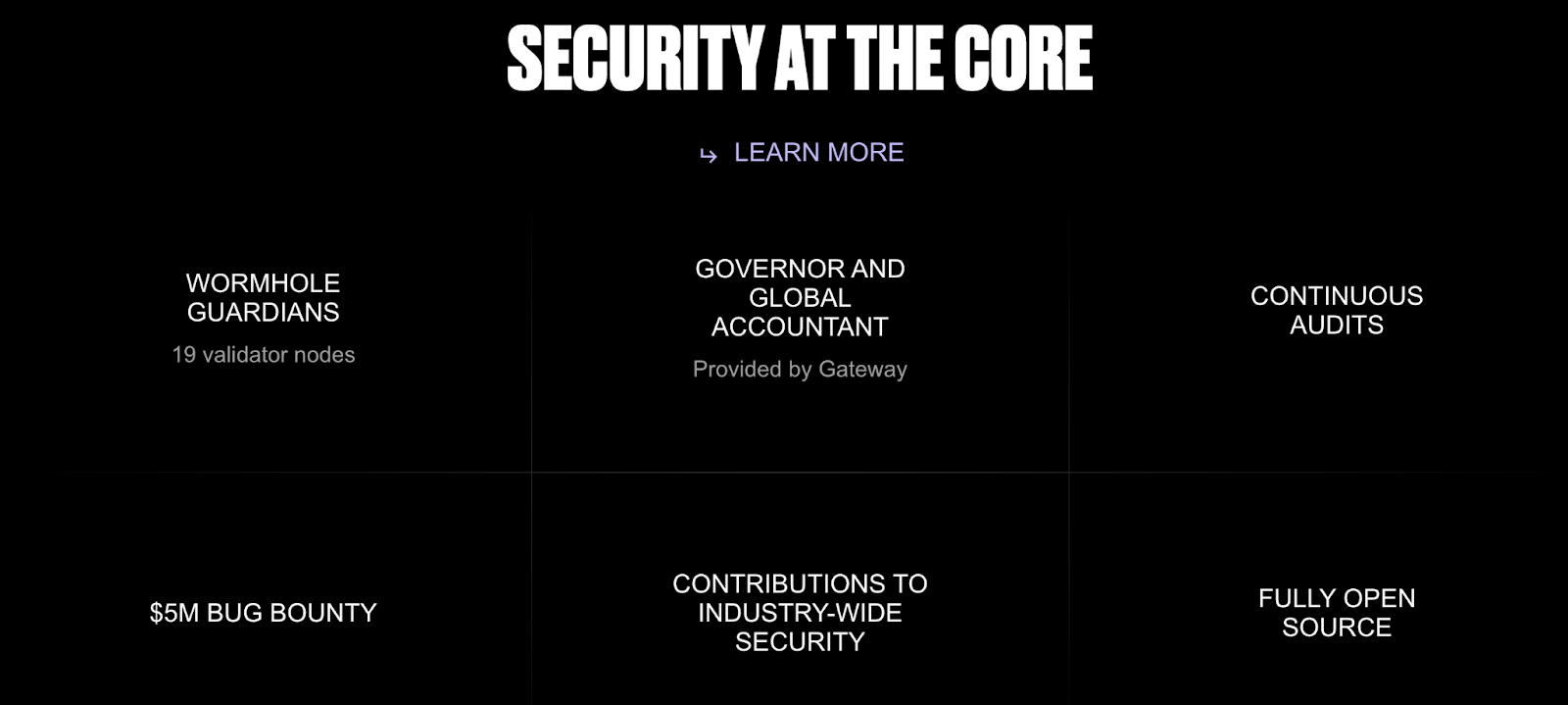
Wormhole interface: Wormhole
How it operates?
Wormhole acts as a bridge between blockchains, facilitating asset transfers with the aid of guardian nodes. These guardian nodes function as checkpoints on a highway—each transaction is scrutinized to ensure compliance with safety standards.
When a transaction is initiated on one blockchain, guardian nodes validate it before it reaches the destination blockchain. If any discrepancies are detected, the transaction is rejected, guaranteeing that only legitimate transfers are processed. This approach maintains end-to-end transaction security even during transfers across different networks.
Wormhole is among the few blockchain security protocols that rely on a decentralized bridge design, offering access to asset recovery tools.
Pros
- Guardian verification: Protects transfers through independent verification at each step.
- Decentralized security: Reduces reliance on a single validator, preventing system-wide vulnerabilities.
- Recovery mechanisms: Provides tools for managing failed or stuck transactions.
Cons
- Bridge vulnerability risks: Like other cross-chain bridges, Wormhole is susceptible to evolving attack methods.
- Complex setup: Users may require time to understand the guardian node system.
Cosmos Hub: Ensuring secure asset transfers with the IBC protocol
The Cosmos Hub facilitates secure cross-chain transactions using its Inter-Blockchain Communication (IBC) Protocol, ensuring safe movement of assets and data between interconnected networks while maintaining transaction integrity. Cosmos minimizes the risk of incomplete or manipulated transfers, guaranteeing secure handling of every step—from sending to receiving.

Cosmos Hub: Cosmos
How it operates?
The IBC protocol functions as a secure delivery network. When tokens are sent from one blockchain to another, IBC ensures that both chains validate the transfer before its completion. It can be likened to a two-way handshake: the sending chain locks the tokens, and the receiving chain issues an equivalent amount only after the initial step is confirmed. Any issues during the process result in the transaction being halted, safeguarding assets from loss.
IBC leverages Tendermint consensus to uphold trust and consistency across blockchains, ensuring accurate validation of transactions without delays or manipulation.
Pros
- Prevention of asset loss: Two-way validation ensures assets are never lost during transit.
- Swift and consistent: Tendermint consensus expedites validation without compromising security.
- Resilience to downtime: IBC can manage network interruptions and safeguard assets until recovery.
Cons
- Network coordination: Requires coordination between multiple blockchains, introducing complexity.
- Limited adoption: Some networks are still integrating IBC, restricting current use cases.
What is end-to-end transaction security?
End-to-end transaction security ensures that every transaction, from initiation to completion, is shielded from risks like manipulation, frontrunning, or incomplete execution.
This concept ensures that no unauthorized entity can tamper with or alter a transaction, instilling complete confidence in users regarding their blockchain activities.
Without proper end-to-end security, blockchain transactions are vulnerable to frontrunning, phishing, or incomplete transfers.
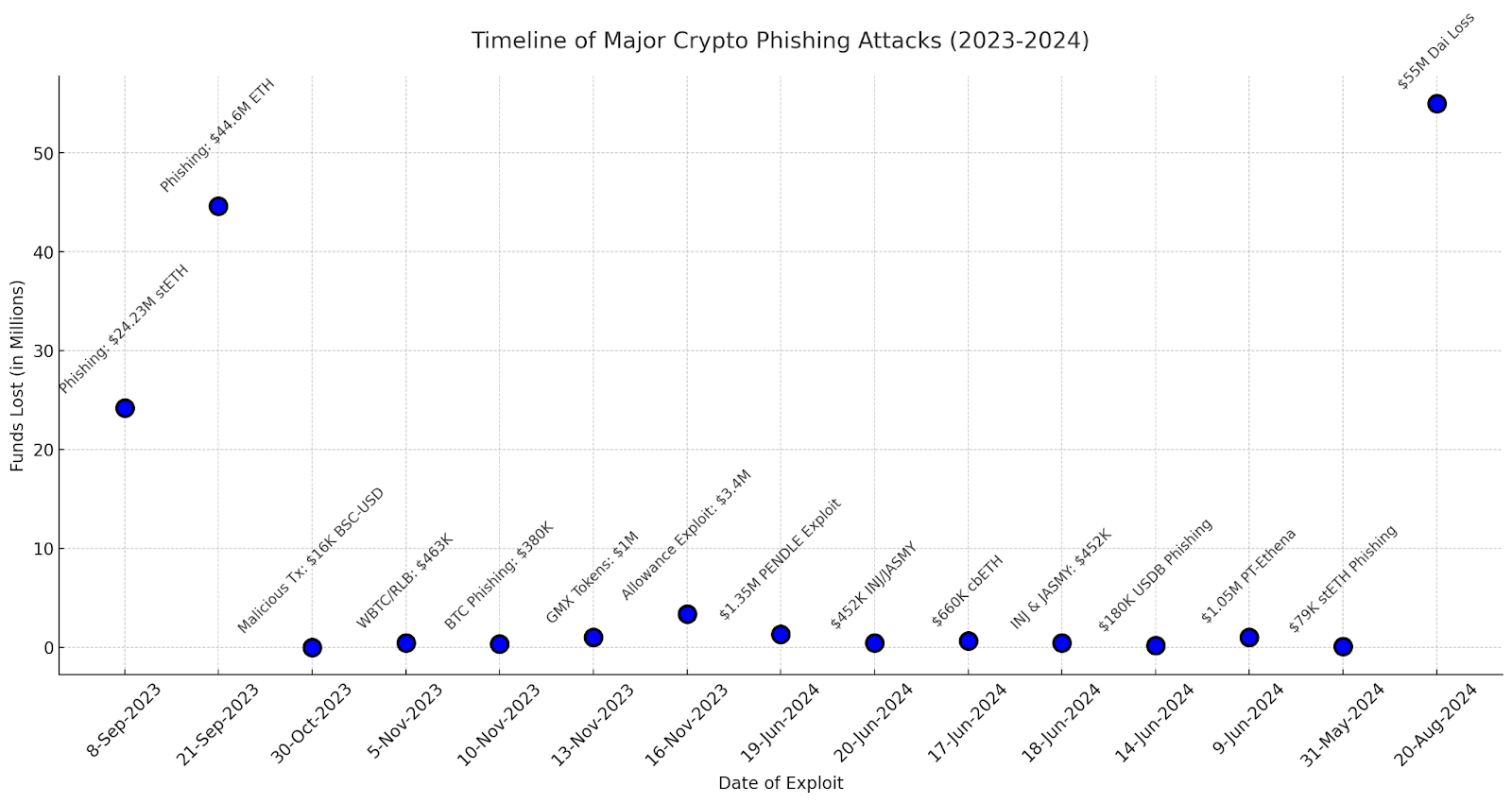
Timeline of major phishing events: BIC
Blockchain security protocols safeguard users’ funds, ensure trustworthiness in smart contract interactions, and prevent data leakage or manipulation throughout the process.

Recent phishing trends: Dune
Is it enough to secure transactions with blockchain security protocols?
While blockchain security protocols are a crucial step towards secure transactions, they may not suffice on their own. These protocols offer end-to-end security, preventing manipulation and verifying data, but evolving threats necessitate continuous enhancements.
A multi-layered approach—comprising user education, audits, and additional safeguards—ensures stronger security and trust across decentralized networks.

